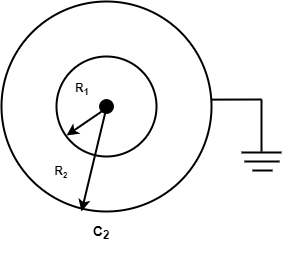Question
Question: The capacity of an isolated sphere is increased \(n\) times when it is enclosed by an earthed concen...
The capacity of an isolated sphere is increased n times when it is enclosed by an earthed concentric sphere. The ratio of their radii is
(A) n−1n
(B) n−1n2
(C) n+12n
(D) n+12n+1
Solution
Hint : To solve this question we have to find the capacitance of two spheres both is concentric. After finding capacitance we have compared both of the equations to find the ratio of their radius.
**Complete step by step answer: ** Let the radius of a first sphere is R1 and radius of other sphere is R2

Here is the potential on the surface of a sphere is V=R1KQ
We let the second plate on the infinite and potential so V1=0
Now we calculate the potential difference between the surface of the sphere and plate on the infinite. Let the difference between both refer to ΔV.
So we can write the equation as
ΔV=V−V1
Here we put the values in the equation
ΔV=R1KQ−0
Then we get,
ΔV=R1KQ
Now we put the value ofKin the above equation
K=4πε01
After putting the value of K we get,
ΔV=4πε0R11⋅Q
Now we calculate charge in the sphere using the following equation
Q=CΔV
Here we put the value of the potential difference in the above equation
Q=C1⋅4πε0R1Q
After solving this equation we get
C1=4πε0R1
Here we get the capacitance in the first sphere.
Now we calculate capacitance on the outer sphere.
The charge on the outer surface of the sphere is negative. And in the inner sphere charge is positive.
So we calculate total potential by both spheres,
V=R2−KQ
V1=R2KQ
So the total potential of both sphere is
ΔV=R2−KQ+R1KQ
Now take K as a common value in the equation
ΔV=K(R11−R21)
Now we put the value of K in the above equation,
ΔV=4πε0Q(R11−R21)
Here we calculate charge in the sphere,
Q=C2ΔV
Here we put the value of the total potential in both sphere,
Q=C2⋅4πε0Q(R1R2R2−R1)
After solving this equation we get the capacitance of both spheres,
C2=R2−R14πε0R1R2
As mentioned in the question the value capacitance of C2 change in n times of C1
nC1=n⋅4πε0R1
Now comparing both equations,
C2=R2−R14πε0R1R2=nC1=n⋅4πε0R1
After solving this equation we get,
⇒R2−R1R2=n
After solving this we get,
⇒R2=nR2−nR1
Take R2 in the other side so we can take R2 it as a common term
nR1=nR2−R2
After taking R2 we get
nR1=(n−1)R2
After further solving
R1R2=n−1n
Here we get the ratio between both spheres is =n−1n
Note: To solve this type of question we have to find the potential difference of both spheres. After that, we calculate charge in both spheres. The charge of the outer sphere is negative but the charge of the inner sphere is positive. Then we calculate the capacitance of both spheres then compares both of them to calculate the ratio of the radius. If we follow these steps we can easily solve this question.
